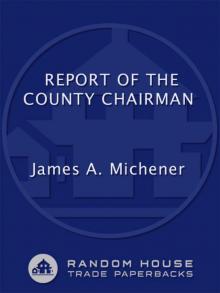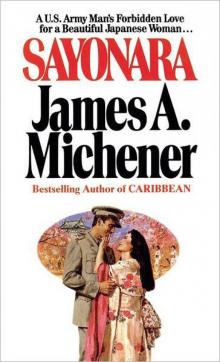- Home
- James A. Michener
Return to Paradise Page 8
Return to Paradise Read online
Page 8
The English provided Robert Louis Stevenson, Rupert Brooke and the queen of gush, Beatrice Grimshaw; while the Americans sent Herman Melville, Jack London, James Norman Hall and lurid Frederick O’Brien. It is provocative to remember that the greatest American novel was conceived in these waters, for without Melville’s stay in Tahiti and the Marquesas there would never have been a Moby Dick. As for Hall, he is the most universally loved American ever to have lived in Tahiti, and one might safely include all Europeans in the comparison. His work is a kind of tribal accomplishment. Boys in Papeete will tell you sorrowfully, “Jimmy is bogged down on Chapter 18.” A Chinese adds, “I hear Hall is going through hell on Chapter 18.” Then a cable arrives from Honolulu: “Got past 18.” The news is flashed about the island. At Quinn’s Eddie Lund cries to passing dancers, “Hey! Hall says he’s past 18.” And everybody is happy that their Jimmy is back on the beam.
But there is another side to the French islands, tragic, lonely, terrible, and no one has perceived it so devastatingly as a thin, mystical Frenchman, one of the greatest navigators who sailed the Pacific, one of the most thoughtful men ever to have immersed himself in an alien civilization. Alain Gerbault was a world-famous tennis player, a gifted writer, a man passionately addicted to the sea. In a pitifully small boat he circumnavigated the globe, and that was his undoing, for he saw the Polynesians. Emotionally he remained a child, obsessed with the terrible tragedy of the French islands.
Listen to a Polynesian: “Alain searched the world over for peace of heart. He found only cruelty, the savagery of white men. He saw my people sitting glassy-eyed while their history and their grandeur dropped away. Alain told me of the wonderful woman who once had known all the chants. Now she got drunk every day. ‘Hello, Alain. I am drunk because my fine son went away.’ He was ten kilometers down the road. The next day, ‘Hello, Alain. I am drunk because my son, he came home.’ ”
Gerbault despised the French policy of selling grog to natives simply because France made a lot of money on wine. (In 1946 returning native soldiers were denied civil service jobs, were paid off in licenses to sell liquor.) He was horrified when he found impoverished natives drinking clorox or worse. He compared their low estate with what Bligh had reported in 1788: “If at any time one of them has been induced by the European seamen to intoxicate himself, such unqualified contempt and disapprobation are manifested toward him by others, and he seems to feel so strongly the impropriety of his own conduct as never to be guilty a second time, even though earnestly entreated.”
Gerbault excoriated Papeete with its cheap white civilization. He called it a “forlorn and disgusting town.” When the French colony tried to lionize him, he ignored them with insults. When the government passed a decree forbidding natives to wear the old pareu, he bought himself a red one and went barefooted through the streets. He tried to waken France’s conscience to the tragedy of Oceania, of the noble Marquesas where ninety-nine out of a hundred had died of disease and despair. He saw those majestic, spired islands when the valleys were empty of sound, when the great artists in wood were no longer even remembered.
“It was a tragedy that never left his mind. He could find no equal to such ruthless destruction by drink, venereal disease, murder and plague. Here was desolation complete, planned and cruel.”
Alain Gerbault died in 1941, “a solitary of the oceans, the poet of the Pacific.” He left behind a book, A Paradise Is Dead, a terrible indictment of all who have betrayed the islands: “the stupid and ferocious administrative machine, the reign of mediocrity, the sailors who debauch the girls, the tourists who bring only the gospel of gold.” He was happy in only one part of Polynesia, and he always referred to that island as “Bora Bora above all.” Where is this remarkable island, considered by most judges to be the most beautiful in the world?
I saw it first from an airplane. On the horizon there was a speck that became a tall, blunt mountain with cliffs dropping sheer into the sea. About the base of the mountain, narrow fingers of land shot out, forming magnificent bays, while about the whole was thrown a coral ring of absolute perfection, dotted with small motus on which palms grew. The lagoon thus subtended was a crystal blue, the beaches were dazzling white, and ever on the outer reef the spray leaped mountainously into the air. That was Bora Bora from aloft. When you stepped upon it the dream expanded.
On Bora Bora lived one of the proudest Polynesian peoples, the last to surrender to French rule. They were brawling, freedom-loving, rugged, good-looking islanders, relishing the old songs and dances. Many visitors other than Gerbault referred to this heavenly spot as “Bora Bora above all.”
Then in the dark days following Pearl Harbor the American Government, as a result of secret negotiations with loyalist French forces, invaded the island with bulldozers, juke boxes, airplanes and lots of money. James Norman Hall has described the cataclysm in Lost Island, whose title betrays his Gerbault-like reaction to the invasion.
But was it a tragedy? I think not. In the last stages of war I was sent to Bora Bora to write the secret history of our occupation and I saw no tragedy. I saw a human comedy, as Balzac understood that poignant phrase. For example, we were governed, Navy-wise, from Samoa, and once a stuffy commander came over to give us a lot of trouble. At a dance where the local girls flourished, this tin-trying-to-become-brass made a series of disparaging remarks about the island skipper. Finally a local girl could stand it no longer. “Worthington!” she shouted. “Hold my teeth.” Thus stripped for battle, she flung herself across the officers’ club and butted the commander right in the belly. After that we had less interference from Samoa.
Traditionally Bora Bora was an island where girls loved to have babies which they could give to older couples who had no children, where fathers built their daughters separate cabins “so they could be alone for their courting.” Imagine dropping several thousand young American men into such a society! The result, as one observer said, “was astonishing and prolific.” The local missionary was able to keep some semblance of order until a lively Bora Bora girl produced a red-haired American son. After that the riot was on. Soldiers and sailors protested when they had to go back to the States, and the islanders protested even more when the last contingent was pulled out. They had found a type of society they liked, a body of men they loved. I probed into all the records of Bora Bora and can say that our men were not a disgrace to their country.
Listen to Homer Morgan and Hank Clarke reporting: “Bora Bora is the loveliest island we ever saw. Maybe that’s because the people knew right away that we were Americans. Wherever we went families hauled out the handsomest kids you ever saw and said, ‘American baby. Nice, eh?’ We counted 103. Half an hour after we landed we were given a bicycle, a free meal and a tour of the island in a jeep. They treated us like visiting potentates and when we left they said with tears in their eyes that they hoped the Americans would all come back some day.”
The nature of my work on Bora Bora drove me to a consideration of the moral problems involved in the submersion of Polynesia. I knew the tragedy of the Marquesas, the disintegration of Tahiti and the brutal annihilations of the Peruvian slavers. No one could even explain such barbarities, let alone condone them; yet I had to conclude that Polynesia could never have escaped the onrush of white civilization, such as it was. These islands were doomed before the white man arrived. The finest young people were associated in fantastic societies which made abortion obligatory. Even the languages were dying. Once-noble Tahitian does not use the following consonants: b, c, d, g, j, k, l, q, s, w, x, y, z—nearby Rurutu also drops f and h, thus having the most meager alphabet known—replacing them by glottal stops between vowels, so that the language sounds like a series of grunts. (In Tahitian oe has four different pronunciations, depending upon the glottal stops: ‘oe was once koe—you; ‘o‘e was once koke—sword; o‘e was once onge—famine; plain oe—bell.) And as for bemoaning the intrusion of white blood, Polynesians themselves are a mixed blood: Indian, Malayan, Javan, Fijian, I
could see no more reason to lament the loss of strictly Polynesian characteristics than I do to bewail the submersion of Picts and Jutes into what later became England. A good people developed there. A very good people is developing in modern Polynesia. (In Aitutaki 76% of births, 1943–46, were half-American children, and the island is reported as never happier, the children never more healthy.)
Population is on the increase. Health services multiply each year, and clean youngsters play basketball and soccer. (In Bora Bora it’s baseball; in Samoa, cricket. Educational facilities are being constantly improved, and the standard of living is being raised. Sentimentalists who moan against natives improving their diet with refrigerators and can openers—“Why, they live on Chinese bread, Australian beef and American pork and beans”—could complain with equal logic that dear old ladies in Boston no longer dip tallow candles because they prefer electricity.
Consider just one small improvement in native life. On the eastern end of Tahiti lives Paeara Tavaearai, a patient, handsome-faced man of sixty. He lives forever on a straw bed, for he has elephantiasis. His hands are like obscene hams, his forearms like the trunks of trees. His legs, stretched helplessly apart, are so big they cannot be moved. Their skin is hard and scaly, like diseased bark. He appears to have no toes and, worst of all, the same gross inflation has reached his scrotum. He has a disease for which there is no cure.
How did it happen? Years ago he was infected by a mosquito which pumped into his blood a host of minute baby worms, called filaria. (The disease which causes elephantiasis is filariasis.) In his body these worms prospered until they became visible to the naked eye—four or five inches long, as thick as a thread—and dangerous to the lymph glands which they congested. Gradually the glands, especially those in the leg, became clogged, whether from the bodies of dead worms, or from their excretions, or because of scar tissue formed by constant irritation is not yet known. At any rate the glands stopped hauling away refuse which now began to collect in the leg.
The first sign of trouble was a crise (kreez), a long, painful red streak along an arm or leg. In time it went away, but inevitably it came back, and when enough years had passed, elephantiasis developed. No one bothered about it much, for it was not a killer. The legs did not become gangrenous because the circulation of blood was not affected. The sick merely hid in back rooms, lived off charity and had no hope.
That is, they had no hope until two spanking bright young Americans arrived from the University of Southern California to help a brilliant French doctor attack this incurable disease. Dr. Henry Beye, a Johns Hopkins graduate, is a gray-haired young specialist in tropical medicine. With the aid of a new drug, hetrazan, he is able to kill microfilaria in the human body. (Mysteriously, microfilaria, the offspring of adult worms, cannot develop into baby worms unless they pass through the body of a mosquito. Most Tahitians carry microfilaria in their blood, harmlessly.) What hetrazan does to the adult worms is not yet known, but Beye thinks it kills them, too. Of course, no drug will reduce the swollen limbs of advanced elephantiasis, but tight bandaging has brought the dried, calloused skin back to pliancy and has effected marked reductions.
Beye is aided by a bullet-headed Kansan, Dr. Allen Edgar, who is death on mosquitoes. He states flatly, “In five years we could lick elephantiasis on this island! All we have to do is kill the mosquitoes.” With DDT, house inspections and clean-up campaigns he is making a big start. Pessimists say, “We’ve always had elephantiasis. When the Americans get tired and go home we’ll have it again.” But in a single year Edgar has effected an immense improvement. (Worst breeders of mosquitoes: rat-eaten coconuts, old automobile tires.)
Two experiences disturb his health program. House 33—he has a number for every house on the island—is set amongst some of the neatest mosquito-free residences in Tahiti. But when he reaches it on his weekly inspection, he shudders. It’s a big, rambling affair with verandahs, long steps and flapping shutters. Six or seven men lounge about, no shoes, pandanus hats, sleeping in the sun. A variety of women live there, too, plus numerous children. There’s a lot of singing, a lot of mosquitoes. In the back, under a tree, two pretty girls in skimpy pareus drowse while a third strums a guitar. When Dr. Edgar approaches with his mosquito trap the girls summon enough effort to shift their legs so that he can see if any mosquitoes have gathered. “Don’t let me interrupt,” he says as he studies the brown ankles. “You won’t,” they assure him drowsily.
Farther along he meets another defeat. Here he has set up a control area, “to be left just as dirty as it always was,” the idea being that mosquito counts would be made here and then compared with the spic-and-span areas which his men had cleaned up. But the local chief, hearing about how fine the rest of the island was looking, organized his people at night to give the area a real brush up. The result: the horrible example has fewer mosquitoes than the DDT areas! Edgar has threatened the chief, but every night the land is swept clean. Says Edgar: “A ridiculous way to conduct an experiment.”
Another American who has had an astonishing effect on Tahiti is dour, tall, competent Leland Carver of Ogden, Utah. An unpaid Mormon missionary, he arrived some years ago with a visionary plan for a great temple. He bought land near Papeete and pitched in. Now it’s completed, a gleaming white, rambling one-story affair built of 60,000 cement blocks he himself poured. The temple, with its fine organ and rich woodwork, is probably the most striking building in the South Pacific. Say the natives proudly: “The only place in Tahiti with nine toilets!”
Tahiti has always had close ties with America. In whaling days it was a stopover point. During Prohibition it was a massive loading port for rum runners that supplied Mexico. But in recent years Americans have been extremely unpopular in Tahiti. Putting it bluntly, they weren’t wanted. In fact, after Russia and Tibet, this island was the most difficult spot in the world for an American to visit. Only the wealthy could meet the financial requirements. (Large deposit refunded in monthly installments after you left the island.) Inflation was astronomical—$1,700 car: $9,000; 89¢ laundry bucket: $11.20—living quarters unavailable, and police surveillance objectionable: If you didn’t spend enough money you were asked to leave.
A Frenchman has said apologetically of this period: “What we really wanted was a cinema in San Francisco called Tahiti Rich Americans would go there, see a colored movie of Moorea, get a frangipani lei, and watch two Tahitians dance. As they left, they’d hand us $3,000. That way we’d have the money, they’d have seen Tahiti, and Papeete wouldn’t be cluttered up with American tourists.”
When I applied for a visa in New York I was told, “Forget it. We just don’t want tourists down there.” In San Francisco I was goaded into making a classic blunder: “But I’ve got to get there. I’m a writer.” The woman in the consulate laughed derisively, “Writers we don’t want. You all turn into beachcombers.”
In desperation I went to Papeete without any visa at all, and the police were so astonished that I would risk a thousand-dollar plane ride when the chances were that I’d be tossed out, that they let me in. And when I landed I found once more that glorious Tahitian sunlight, the happiness, the friendliness. (In terms an American will appreciate: On the first day three strangers offered to lend me their cars. I took them, in turn.)
Moreover, I found that Governor Anziani, a well-trained economist, had come out from Paris determined to remove the insults under which Americans had suffered. The welcome is now wholehearted. There’s even an official committee, with government funds, to make the American feel that he is an honored guest. A new hotel is planned, new swimming beaches, bright attractions. In the meantime, at Les Tropiques, you can rent a five-room bungalow ten feet from the lagoon and with a view of Moorea for $80 a month.
But for many years the cost of a trip to Tahiti will be great. By plane you can get to Australia for less ($640) than you can get to Tahiti ($650). By boat it’s very difficult. Big liners no longer call. Small freighters are jammed months in advance. (“Sorry! We
can’t even put your name on the waiting list for the next eight months.”) And when you reach Tahiti you ought to count on spending about $500 a month. You can get by on $300 if you skimp on taxis, but the businessmen say frankly, “We want the rich tourists, not cheapies who have a high time on five bucks a day.” Says the earlier apologist, “We still want that $3,000, but we realize we have to take the tourist too.”
A primary cause of high prices is the inadequate money system. The lowest practical unit is the five-franc note, equal to 8¢. (There are coins and notes of smaller denomination, but rarely used.) Therefore, everything that in another country would be a nickel is 8¢—ice cream, shoe strings, bananas—which is pretty bad, but dime articles are worse. They cost 16¢!
In addition, the money that is available is the filthiest, raggedest, most loathsome stuff that could be passed from hand to hand. I have just come from the bank and have fourteen notes before me. There are six different sizes, the largest suitable for a place mat at a bridge luncheon, the smallest about the size of a Liberian postage stamp.
Not one of the bills is untorn. The worst is indescribable, a tattered, sweaty smear with all corners missing. The best is mended with a chunk of brown butcher paper. Each is begrimed, sleazy, and repulsive.
I asked a Frenchman how a colony could tolerate such a currency. (No wallet can be devised to hold the fodder. Some women carry raffia bags a foot square.) He replied, “So much of it wears out while in use that the bank makes an automatic profit of 4%.” The most ridiculous aspect is that even the Government quotes prices for which no change can possibly be made. (Eighty centimes for a letter.) Today in Tahiti’s largest store I was given my change in matches! At the post office you get it in postage stamps, “which,” adds the Frenchman, “get lost, so there’s another ½% profit!”

 Mexico
Mexico The World Is My Home: A Memoir
The World Is My Home: A Memoir Sayonara
Sayonara Chesapeake
Chesapeake The Novel
The Novel Rascals in Paradise
Rascals in Paradise Return to Paradise
Return to Paradise Presidential Lottery: The Reckless Gamble in Our Electoral System
Presidential Lottery: The Reckless Gamble in Our Electoral System The Source
The Source Poland
Poland Space
Space Caravans
Caravans Creatures of the Kingdom: Stories of Animals and Nature
Creatures of the Kingdom: Stories of Animals and Nature Iberia
Iberia Hawaii
Hawaii The Watermen: Selections From Chesapeake
The Watermen: Selections From Chesapeake Report of the County Chairman
Report of the County Chairman The Covenant
The Covenant The Bridges at Toko-ri
The Bridges at Toko-ri Matecumbe
Matecumbe Journey: A Novel
Journey: A Novel Centennial
Centennial Sports in America
Sports in America Texas
Texas Miracle in Seville
Miracle in Seville This Noble Land: My Vision for America
This Noble Land: My Vision for America Tales of the South Pacific
Tales of the South Pacific Bridges at Toko-Ri
Bridges at Toko-Ri Space: A Novel
Space: A Novel Presidential Lottery
Presidential Lottery Sayonara: A Novel
Sayonara: A Novel This Noble Land
This Noble Land The Covenant: A Novel
The Covenant: A Novel Miracle in Seville: A Novel
Miracle in Seville: A Novel The Bridge at Andau
The Bridge at Andau Source
Source The Source: A Novel
The Source: A Novel Journey
Journey Recessional: A Novel
Recessional: A Novel Legacy: A Novel
Legacy: A Novel The Bridges at Toko-Ri: A Novel
The Bridges at Toko-Ri: A Novel Poland: A Novel
Poland: A Novel